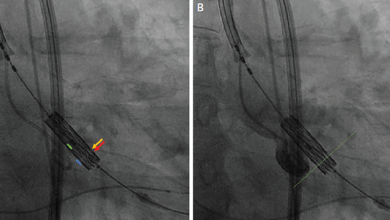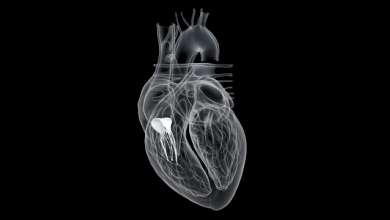Search results
Author(s):
Leif Thuesen
,
Niels Ramsing Holm
Added:
3 years ago
Bifurcation lesions are frequent and account for about 15 % of all percutaneous coronary intervention cases.1 Bifurcations are a challenging lesion subset involving a main vessel (MV) and its side branch (SB). A bifurcation lesion may be looked upon as the proximal MV, the distal main vessel, the SB and the area of the bifurcation. Short- and long-term results depend on optimal handling of all…
View more
Provisional Stenting Tricks
Author(s):
Francesco Burzotta
,
Carlo Trani
Added:
3 years ago
Article
Author(s):
Kay Woon Ho
,
Vladimír Džavík
Added:
3 years ago
Techniques and devices used in percutaneous coronary intervention (PCI) have evolved significantly since the inception of the procedure. Procedural and patient outcomes have improved, while more complex coronary lesions in high-risk patients are being attempted with increasing frequency. High-risk procedures are carried out in patients with marked left ventricular dysfunction, acute coronary…
View more
Author(s):
Nicolas Foin
,
Eduardo Alegria-Barrero
,
Ryo Torii
,
et al
Added:
3 years ago
Drug-eluting stents (DESs) have contributed to a significant lowering of the incidence of restenosis and target vessel revascularisation (TVR) in bifurcations.1–4 A randomised study of bifurcation lesions using sirolimus-eluting stents revealed restenosis rates of only 4 % in the main branch (MB) and a TVR rate as low as 8.2 % at six-month follow-up,2 a marked improvement over that in historical…
View more
Author(s):
Kamal Chitkara
,
Anthony H Gershlick
Added:
3 years ago
First-generation Stents
Since drug-eluting stents (DES) received the CE mark in 2002 and the US Food and Drug Administration (FDA) approved the first DES in 2003, there has been a significant increase in the use of these devices. The advent of DES has revolutionised the field of interventional cardiology by having a major impact on patient care through their efficacy in reducing the need for…
View more
Author(s):
J Raider Estrada
,
Jonathan D Paul
,
Atman P Shah
,
et al
Added:
3 years ago
While the breadth of procedural offerings in interventional cardiology (IC) has exponentially expanded over the past four decades to include cardiac structural, peripheral arterial, and venous interventions, percutaneous coronary intervention (PCI) remains at the core of the field, accounting for the greatest percentage of therapeutic catheter-based procedures performed by IC practitioners in the…
View more
Author(s):
Shu-I Lin
,
Mizuki Miura
,
Ana Paula Tagliari
,
et al
Added:
3 years ago
Transcatheter aortic valve implantation (TAVI) is now established as the standard treatment for symptomatic severe aortic stenosis (AS) in patients at high or prohibitive surgical risk, and the preferred treatment for those at intermediate risk.1
Based on recent trials in low-risk patients, the indications for TAVI are expanding towards the lower-risk classes, and the procedure has even been…
View more
Author(s):
Alfonso Ielasi
,
Alaide Chieffo
Added:
3 years ago
A critical stenosis in left main coronary artery (LMCA) is observed in 3–5% of all patients who undergo coronary angiography and in 10–30% of patients who undergo coronary artery bypass grafting (CABG).1 Significant LMCA disease is a high-risk condition because of the extent of jeopardised myocardium.
Current practice guidelines recommend CABG as the standard therapy for patients with…
View more
Author(s):
Jonathan Curio
,
Ozan M Demir
,
Matteo Pagnesi
,
et al
Added:
3 years ago
Tricuspid regurgitation (TR) is common, affecting 5% of the elderly population and, when its severity reaches moderate to severe, is an independent predictor of increased mortality.1–3 The pathophysiology of TR is mainly functional as it occurs in the context of pulmonary hypertension, left-sided heart disease and AF.4 These lead to deformation of the right ventricle (RV) and the right atrium (RA…
View more














 « First
« First